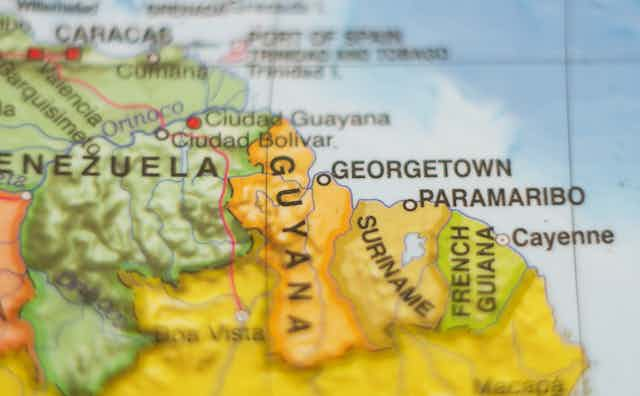Four and half thousand miles from the UK, right next door to oil-rich basket case Venezuela, lies a country that might be strangely familiar to British readers. The locals speak English, play cricket, and some spend their Sunday mornings at St George’s Anglican cathedral.
Guyana’s colonial trappings are clear, but perhaps the most powerful effect is seen in an entrenched and lingering inequality that can tell us much about unfairness in wealth and incomes around the world.
My research shows that the socio-economic structure created by colonial elites in British Guiana persists in independent Guyana. In other words, the structure of economic and ethnic inequality has less to do with skills, education and technology. This is contrary to the popular explanations of the distribution of income and wealth.

Wealth of nations
Guyanese with Portuguese origin almost exclusively occupy the top 10% of the income distribution. They also took in about 41% of total income in 2013. This oligarchic group has survived economic crises, ethnic clashes and even “socialist” transformations in Guyana. Historically, the white plantocracy allowed Portuguese immigrants to monopolise commerce in British Guiana and as the evidence shows, their economic power has not waned.
The situation is strikingly similar to South Africa, where the white economic elites have survived a “democratic transition”. Supposedly, democracy imposes an enormous redistributive burden. The evidence points to the contrary.
But the enormous economic power of the top 10% is largely hidden from scrutiny. The wider Guyana is preoccupied with social conflict between Indian and African Guyanese that often sees highly contested elections and ethnically charged protests . Historically, colonial elites used immigrant Portuguese as a buffer between the planter class and the newly freed slaves and other immigrants.

Distractions are a powerful means by which economic power remains concentrated. Think of the spate of attacks on African Americans by police in the US. This has the effect of inserting race as a distraction from fundamental economic disparities. Working class Americans preoccupied with racial strife are unlikely to bargain as a united class in the struggle against patrimonial capitalism. You might wonder if Brexit acts as a similar distraction in the UK.
Hiding behind metrics
Still, the power of economic elites extends beyond social buffers. They hide in plain sight. They hide behind the veil of metrics. Notwithstanding the enormous income share of Guyana’s top 10%, standard metrics such as the Gini coefficient suggest that income inequality has declined in Guyana.
The Gini coefficient is the most commonly used measure of inequality and assumes a numerical value between 0 and 1, where 1 indicates that a single individual owns all the income in a country and zero depicts equal income share for everyone. The UK has a Gini coefficient of 0.358 and Iceland 0.244. Guyana’s improved from 0.44 to 0.35 between 1992 and 2006.
But the Gini is more sensitive to changes in the middle class and less so to the lower end of income distribution. If we trace the income share of the top 10% as a ratio of the poorest 40% (known as the Palma ratio), we see a far less optimistic image.
In the Guyana case, the Palma ratio has increased tremendously. It follows that researchers, analysts and social activists must exercise great caution when using the Gini. The super rich tend to hide behind the less stark picture that it can offer.
IMF and inequality
Though a decline in Guyana’s Gini suggests a growth in the middle class, it only earned 46% of total income in 2013, marginally more than the top 10%. Astonishingly, the bottom 50% owns a mere 12% of total income. But these facts only provide a partial view.
Since the early 1990s, Guyana’s bottom 50% has consumed more than its income every year. But hardly because of irresponsible spending. Chronic internal and external imbalances drove Guyana to sign onto an IMF program which imposed austerity and internal devaluation in the 1990s and led to a collapse in their mean income. It is the good fortune of remittance inflow in kind and cash from overseas-based Guyanese in the UK, US and Canada that supports the bottom 50%. Remittances are so substantial they outpace foreign direct investment and official development assistance.

In the absence of such good fortune in the eurozone periphery, austerity leads to higher inequality and less consumption. This inevitably pushes southern Europeans below the poverty line. Guyana demonstrates that after the fall in income during the 1990s, the bottom 50% is yet to recover to its 1976 peak in mean income. This predicts a dismal story for the poorest Europeans.
On the other hand, Guyana’s top 50% has fully surpassed its 1976 peak. Especially the top 10%. IMF-style policies are still push factors on the side of higher inequality notwithstanding their intellectual acknowledgment of the problem of inequality.
The Way Forward
Outside of the West, income data on the super rich is for all practical purposes non-existent. This makes progressive income taxation difficult, if not impossible. Policymakers could seek refuge in fêted tax theorist Henry George and place greater emphasis on taxing land and property.
Property taxation has less disincentive effects as compared to income and labour taxation. Higher property taxes do not lead to less land or property, but can serve as an important redistributive tool. Unlike income, property can be easily identified and valued even in less developed countries, attractive features for inefficient and under-resourced tax administrations.
But given inter-ethnic conflict in Guyana and other economic and political rivalry across the wider developing world, it is difficult to imagine the political basis for higher taxation on property. In other words, the top 10% are enjoying the benefits of a distracted and divided working poor.
The solution to economic inequality lies in the world of politics. It requires leadership that can unite a divided people in the common interest of class conflict. This is as true in the developing world as it is in developed countries.

